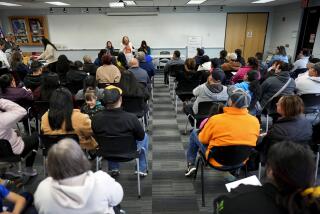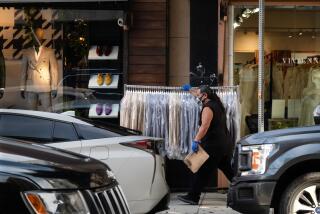Iowa and Hong Kong Weave an Unusual Alliance : Amana Garment Plant Uses Imported Technology to Edge Out Foreign Rivals
- Share via
Garment making has come to the verdant, rolling hills of Amana, Iowa, the home of farmers, refrigerators, microwaves, furniture makers and dandelion wine.
The unlikely new venture--funded in part by a Hong Kong clothing maker--started up in January. That was nearly three years after the Amana Society, a circle of seven villages in east-central Iowa, and Iowa Electric Industries, the state utility company, first came up with an idea to refurbish a defunct woolen mill and provide jobs for some of the rural area’s unemployed.
“For years and years, we have been exporting our technology to other countries, allowing them to use that technology to compete against us in the marketplace,” said Dennis M. Schrag, general business manager of the Amana Society and chairman of Amana Society Enterprises, the garment-making venture. “We’re reversing that a little bit, like Honda. We are importing the technology and trying to compete with Hong Kong manufacturers domestically.”
The Japanese auto maker Honda, which has a plant in rural Marysville, Ohio, and other foreign companies have been producing cars, steel and electronics in this country for some time, occasionally in partnership with U.S. companies. Recently, offshore manufacturers have announced plans to establish joint ventures in this country to make textiles, including a $45-million cotton mill scheduled to open in October, 1989, in Fresno.
But sources in the apparel industry and in trade development say they know of no other U.S. garment-making plants, aside from the Amana operation, that have been set up in partnership between U.S. and offshore companies. Because 52% of the apparel sold in this country is made overseas, clothing industry representatives like the idea of anything that could help turn the tide back to domestic production--even a small step such as the Amana plant.
Expect Significant Influx
“We’re anxious to have as much production onshore as possible,” said Larry Martin, director of government relations for the American Apparel Manufacturers Assn. in Arlington, Va. “If the people in Hong Kong want to do it, that’s all right.”
Industry sources say they foresee a significant influx of foreign apparel manufacturers to this country--partly because of overseas quota considerations but also because these companies see a growing demand for domestically made apparel that can find its way to store racks four to six weeks faster than items made in Europe or Pacific Rim nations. And because they are not subject to quotas or tariffs, U.S.-made goods can often be priced more competitively.
“Many of the offshore suppliers have a clearer understanding of the significance of quick delivery,” one retailing source noted.
One such supplier is K. Y. So, a Hong Kong garment maker who in late 1986 was introduced to an Iowa Electric official by a friend and learned about the proposed venture. “K. Y. was overwhelmed by their sincerity and decided to invest,” said Scotty Fung, general manager of So’s Tung Shun Hing Garment Factory in the Kowloon side of Hong Kong.
The impetus for the Amana project was the closing of the area’s century-old woolen mill and the layoffs of 100 people.
“We are fundamentally an agricultural area, and the agricultural economy and Iowa economy in general have not been terrific,” Schrag said. “We decided that we needed to find some way of replacing those lost jobs.”
Each of the three partners supplied more than $200,000, and the state supplied an additional $25,000 in economic development funds and $40,000 in training funds. The plant’s nearly 50 employees are being trained on highly automated, Japanese-made sewing and cutting machines even as they turn out garments.
So far, the most monumental task was producing 11,000 skirts for Eagle’s Eye, a clothing manufacturer in Malvern, Pa. The skirt involved about 25 production steps, including darts, pleats and pull strings. “It really put our people through their paces,” Schrag said. He added that the plant, which plans a formal opening ceremony late this month, expects to begin turning a monthly profit by late summer.
The plant also provides a pattern-making and design service. “That gives us a little edge in the market,” said Cheryl Stone, the plant’s general manager and a Los Angeles native who went to Inglewood High School and UCLA.
Of the plant, Stone said: “We don’t have a sweatshop.” From their well-lighted upstairs factory, workers look out on farmland, an old mill stream and the picturesque environs of the Amana colonies, founded in the mid-1800s by a group of German immigrants who had fled their homeland because of religious persecution.
These colonists found fertile farmland and forests with abundant hard wood for furniture making. The Iowa River created water power to run factories. Woolen mills, wineries, bakeries, meat-smoking plants and other businesses sprang up and gained a reputation for turning out high-quality goods. Amana Refrigeration, one of the area’s better-known businesses, now makes microwaves, refrigerators and freezers as a unit of Raytheon Corp.
Courted Major Retailer
For decades, the residents maintained their self-sustaining, communal ways. But in 1932, the colonists embarked on “The Great Change”--an overnight shift from communism to capitalism. These days, the seven villages, with a population of 1,600, maintain a healthy tourist trade as well as a variety of businesses and services. The area has also attracted a number of Asian refugees, a few of whom work at the garment plant.
When it came time last August to drum up business for the plant, Schrag headed to another heartland community, Columbus, Ohio, where the Limited Inc. demonstrated its own potent desire for U.S.-made apparel at a trade fair for domestic manufacturers.
As a result of contacts made there, the specialty apparel retailer placed more than $40 million worth of orders with new U.S. producers, said Limited Vice President Alfred S. Dietzel. And the Limited, which last year had sales of $3.5 billion, plans to hold another trade fair this August.
Schrag said the Amana venture hopes eventually to supply garments to some of the Limited’s divisions, including Henri Bendel, a high-fashion store that the Limited expects soon to expand beyond its one-store base in Manhattan.
Although some retailers have complained for months about weak apparel sales, the Amana plant can scarcely keep up with demand. Its biggest problem is finding enough domestically made fabric.
“We found a tremendous demand for domestically made sportswear,” Schrag said. “Even here in Iowa, not typically a high-demand sportswear area, we have customers within 25 miles of us that could consume our entire production.
“That little ‘Made in the U.S.A.’ tag has a lot of power to it now,” he added. “It certainly does in the Midwest, in Iowa.”
More to Read
Inside the business of entertainment
The Wide Shot brings you news, analysis and insights on everything from streaming wars to production — and what it all means for the future.
You may occasionally receive promotional content from the Los Angeles Times.











